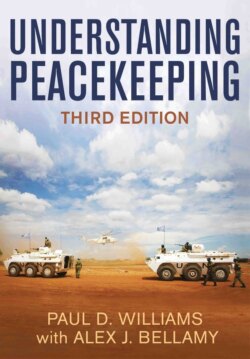Читать книгу Understanding Peacekeeping - Alex J. Bellamy - Страница 39
The financial framework for UN peace operations
ОглавлениеPaying for the UN’s peace operations has always been a source of political debate and sometimes of controversy. The controversy has intensified as the cost of peacekeeping has risen. Between 1947 and 2019, the UN spent approximately $140 billion to sustain all its more than seventy peacekeeping operations (see figure 2.4). Before 1988, however, the UN routinely spent around $300 million a year on peacekeeping, a figure that in 1993 rose to $3.6 billion. By 2005, expenditure on peace operations had reached more than $4.5 billion and in 2016 it reached a peak of over $8 billion.
No official financial system of paying the UN’s peacekeeping bill existed until the financial crisis generated by the organization’s mission in Congo (ONUC, 1960–4). The relatively large sums of money involved prompted member states to establish a separate system for peacekeeping budgets in 1973, although some operations were still subsequently funded by voluntary contributions. Even after a system was developed, however, paying the bills for peacekeeping operations was complicated. While the UN’s special political missions – comprised mainly of civilian personnel – are paid for out of the regular budget, paying for most peacekeeping missions involving military and police contingents is much more complicated for several reasons (Williams 2018a). The only two exceptions are UNTSO in the Middle East and UNMOGIP in Kashmir, which are paid for from the regular budget because they were established before the current financial system was created.
Figure 2.4 UN peacekeeping expenditures, 1947-2019 (US$ millions current not adjusted for inflation)
Source: Updated and adapted from Coleman (2014: 3) and United Nations https://peacekeeping.un.org/en/how-we-are-funded.
First of all, it is impossible to predict how much peacekeeping will be required in any particular year, especially given the possibility of establishing new missions to respond to crises. The costs can therefore increase significantly and unexpectedly.
Second, there is no single, permanent budget for peacekeeping because, despite being the organization’s most visible activity, peacekeeping is still not officially considered one of the UN’s core functions for budgetary purposes. Instead, each mission has a separate budget. There are also two additional accounts which cover logistics and headquarters support costs, but these are paid for out of each peacekeeping mission budget. It is debatable whether operating multiple separate mission budgets helps ensure better financial management than a single, fungible account. But the latter would certainly provide greater flexibility and help with issues concerning inter-mission cooperation.
Third, all UN member states are expected to pay a slice of the overall annual bill for peacekeeping, but the slice varies considerably. The rates of assessment are the product of international negotiations in the General Assembly that take place every three years. These negotiations agree on a formula which the UN then uses to calculate the assessed rates for each member state, which reflect the updated economic data. The formula takes into account each country’s share of the UN regular budget, to which countries with lower per capita incomes are granted discounts that are offset by additional payments (a ‘premium’) paid by the P5 members of the UN Security Council to reflect their role in peace and security. Since 2000, and following US-led pressure, a series of reforms were enacted that altered the distribution of payments within the UN’s peacekeeping budget. This resulted in a change from the old system – based on four categories of states: P5, Developed, Developing and Least Developed – to a new system – based on ten categories of states, labelled A (the highest) through J (the lowest) – for raising peacekeeping assessments that differed from the general UN dues. In addition, many states also make voluntary contributions on a non-reimbursable basis in the form of transportation, supplies, personnel and financial contributions above and beyond their assessed share of peacekeeping costs. In December 1994, the General Assembly’s Fifth Committee decided that the financial year for each peacekeeping operation shall be from 1 July to 30 June. The group scales of assessment for peacekeeping contributions for 1999, 2005 and 2016 are shown in table 2.2.
Fourth, the payment of assessments in full and on time is important because the countries that contribute peacekeepers in the field rely on a system of reimbursements from the UN. These reimbursements are intended to help reduce the financial barriers that contributing countries face in their efforts to help maintain international peace and security by participating in peacekeeping. Personnel reimbursement reduces the cost of common and essential additional costs such as vaccinations and training but doesn’t cover salaries and benefits. There is a separate system for reimbursing equipment. The UN calculates the relevant reimbursements and pays them subject to various conditions being met, such as signing a memorandum of understanding (MOU) with the contributing country and having sufficient cash available. Consequently, if the UN’s member states don’t pay their contributions in full and on time, it is likely to be the countries contributing the most peacekeepers that suffer financially. Part of the problem is that some rich states have refused to pay their peacekeeping assessments on time, causing a persistent financial crisis staved off only by the practice of volunteer states loaning money and equipment to the UN. By the end of 2008, the level of outstanding contributions to peacekeeping was just under $3 billion. By April 2020, the figure was about $2.2 billion, about $1.3 billion of which was owed by the United States. It should be noted that the figure for arrears fluctuates constantly.
Table 2.2 Old and new UN peacekeeping scales of assessment
Source: Durch and Berkman (2006: 37); UN doc. A/70/331/Add.1, 28 December 2015.
